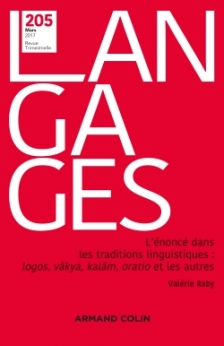
Langages n° 205 (1/2017)
Pour acheter ce numéro, contactez-nous
Recevez les numéros de l'année en cours et accédez à l'intégralité des articles en ligne.
Le présent article s’intéresse aux premières interactions, dans l’Inde médiévale, entre la tradition grammaticale pan. inéenne et l’exégèse du Veda (Mımamsa) sur la question des définitions de l’énoncé (vakya). Une première section retrace l’apparition du problème dans la grammaire ancienne et met en évidence le conflit opposant, sur ce point, ses deux plus vénérables autorités : Pan. ini (IVe s. AEC) et Katyayana (IIIe s. AEC). La seconde section s’intéresse à la relecture de ce débat au Ve siècle (EC) par Bhartr̥hari, l’auteur du Vakyapadıya (« Traité du Mot et de la Phrase »). On y montre comment Bhartr̥hari, sous couvert de réconcilier Panini et Katyayana, introduit dans la grammaire une définition de l’énoncé sur une base sémantique (et non plus simplement formelle) qu’il emprunte à l’exégèse, annonçant par là sa propre théorisation de l’énoncé comme entité « indivise » (akhanda) dans le Vakyakanda.
This paper focuses on the early interactions, in medieval India, between the traditions of Pan. inian grammar (Vyakaran. a) and Vedic exegesis (Mımamsa) on the definitions of the sentence (vakya). The first section discusses the origins of the debate in ancient grammar, and highlights the existence of a conflict between two of its most prominent authorities: Pan. ini (4th century BC) and Katyayana (3rd century BC). A second section deals with the contribution to this debate made by Bhartr̥hari (5th century AD), the author of the Vakyapadıya (“A Treatise on the Word and the Sentence”). It is shown that Bhartr̥hari, even while claiming to reconcile Pan. ini and Katyayana, introduces into Vyakaranaa definition of the sentence on a semantic (and not merely formal) basis, which he borrows from Vedic exegesis. This borrowing appears as a preliminary to his own theorisation of the sentence as “undivided” (akhanda) in the Vakyakanda.